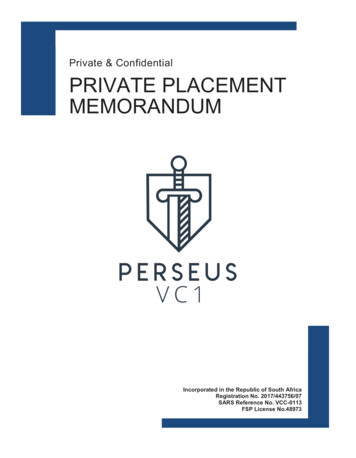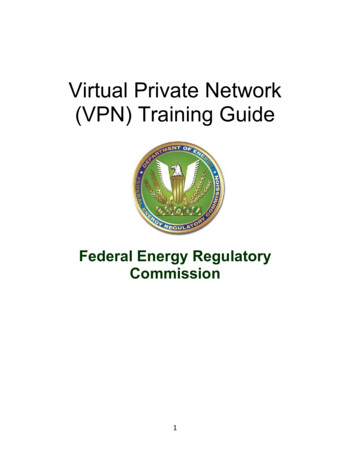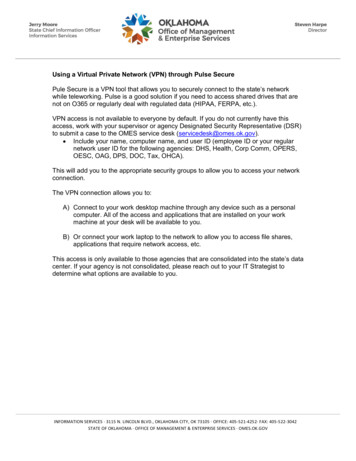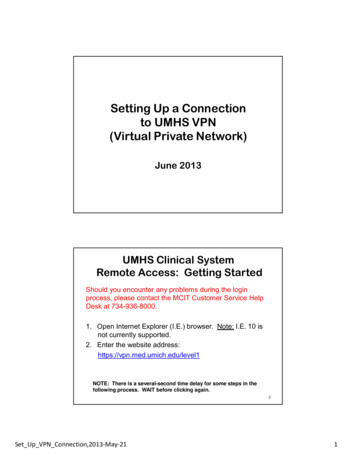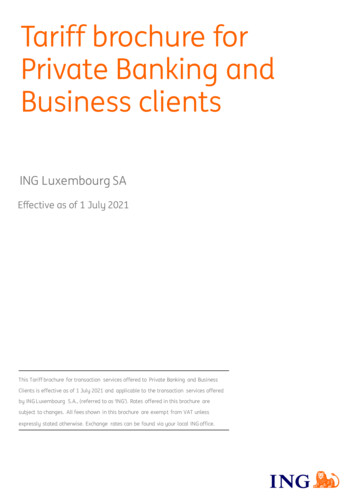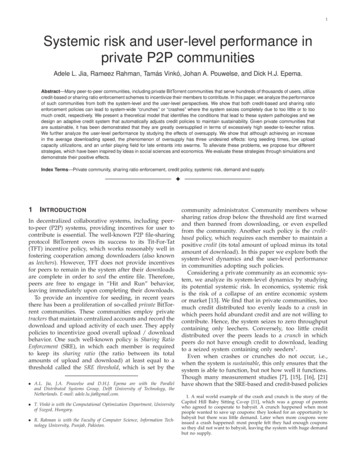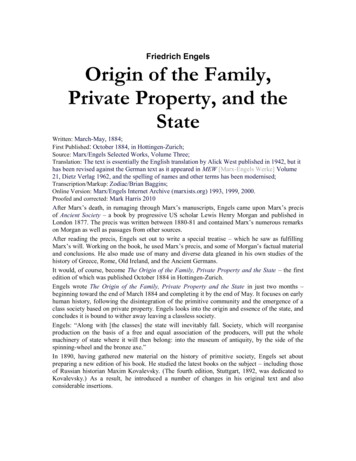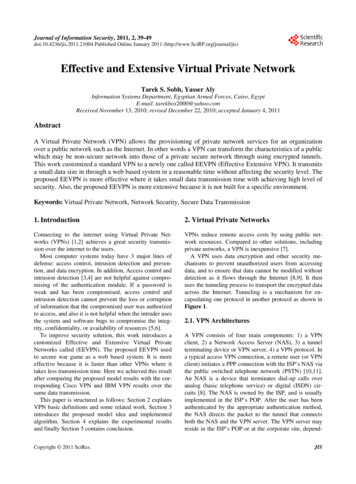
Transcription
Journal of Information Security, 2011, 2, 39-49doi:10.4236/jis.2011.21004 Published Online January 2011 (http://www.SciRP.org/journal/jis)Effective and Extensive Virtual Private NetworkTarek S. Sobh, Yasser AlyInformation Systems Department, Egyptian Armed Forces, Cairo, EgyptE-mail: tarekbox2000@yahoo.comReceived November 13, 2010; revised December 22, 2010; accepted January 4, 2011AbstractA Virtual Private Network (VPN) allows the provisioning of private network services for an organizationover a public network such as the Internet. In other words a VPN can transform the characteristics of a publicwhich may be non-secure network into those of a private secure network through using encrypted tunnels.This work customized a standard VPN to a newly one called EEVPN (Effective Extensive VPN). It transmitsa small data size in through a web based system in a reasonable time without affecting the security level. Theproposed EEVPN is more effective where it takes small data transmission time with achieving high level ofsecurity. Also, the proposed EEVPN is more extensive because it is not built for a specific environment.Keywords: Virtual Private Network, Network Security, Secure Data Transmission1. Introduction2. Virtual Private NetworksConnecting to the internet using Virtual Private Networks (VPNs) [1,2] achieves a great security transmission over the internet to the users.Most computer systems today have 3 major lines ofdefense: access control, intrusion detection and prevention, and data encryption. In addition, Access control andintrusion detection [3,4] are not helpful against compromising of the authentication module. If a password isweak and has been compromised, access control andintrusion detection cannot prevent the loss or corruptionof information that the compromised user was authorizedto access, and also it is not helpful when the intruder usesthe system and software bugs to compromise the integrity, confidentiality, or availability of resources [5,6].To improve security solution, this work introduces acustomized Effective and Extensive Virtual PrivateNetworks called (EEVPN). The proposed EEVPN usedto secure war game as a web based system. It is moreeffective because it is faster than other VPNs where ittakes less transmission time. Here we achieved this resultafter comparing the proposed model results with the corresponding Cisco VPN and IBM VPN results over thesame data transmission.This paper is structured as follows: Section 2 explainsVPN basic definitions and some related work. Section 3introduces the proposed model idea and implementedalgorithm. Section 4 explains the experimental resultsand finally Section 5 contains conclusion.VPNs reduce remote access costs by using public network resources. Compared to other solutions, includingprivate networks, a VPN is inexpensive [7].A VPN uses data encryption and other security mechanisms to prevent unauthorized users from accessingdata, and to ensure that data cannot be modified withoutdetection as it flows through the Internet [8,9]. It thenuses the tunneling process to transport the encrypted dataacross the Internet. Tunneling is a mechanism for encapsulating one protocol in another protocol as shown inFigure 1.Copyright 2011 SciRes.2.1. VPN ArchitecturesA VPN consists of four main components: 1) a VPNclient, 2) a Network Access Server (NAS), 3) a tunnelterminating device or VPN server, 4) a VPN protocol. Ina typical access VPN connection, a remote user (or VPNclient) initiates a PPP connection with the ISP’s NAS viathe public switched telephone network (PSTN) [10,11].An NAS is a device that terminates dial-up calls overanalog (basic telephone service) or digital (ISDN) circuits [8]. The NAS is owned by the ISP, and is usuallyimplemented in the ISP’s POP. After the user has beenauthenticated by the appropriate authentication method,the NAS directs the packet to the tunnel that connectsboth the NAS and the VPN server. The VPN server mayreside in the ISP’s POP or at the corporate site, dependJIS
40T. S. SOBH ET AL.ing on the VPN model that is implemented.The VPN server recovers the packet from the tunnel,unwraps it, and delivers it to the corporate network. Figure 2 illustrates VPN architecture. There are four tunneling protocols used to establish VPNs, and three areextensions of the Point-to-Point Protocol (PPP)[5,6,10,11]: 1) Point-to-Point Tunneling Protocol (PPTP).2) Layer 2 Forwarding (L2F). 3) Layer 2 Tunneling Protocol (L2TP). 4) IP Security (IPSec) Protocol Suite. Inthis Section we will discuss IPSec with some details because IPSec can work with IP4 and IP6.IPSec provides cryptography-based protection of alldata at the IP layer of the communications stack. It provides secure communications transparently, with nochanges required to existing applications [12,13].IPSec protects network traffic data in three ways [12,13]: 1) Authentication: The process by which the identityof a host or end point is verified. 2) Integrity checking:The process of ensuring that no modifications were madeto the data while in-transit across the network. 3) Encryption: The process of “hiding” information while intransit across the network in order to ensure privacy.2.3 Commercial VPNsMany companies produced a lot of VPNs deals with dif-ferent data sizes. On the other hand a few works that dealwith small data sizes especially less than 1 MB, becauseit is a special purpose for specific application such asWar Game which needs high security with low timetransmission.Here we will discuss two popular VPN commercialproducts Cisco VPN and IBM VPN. There are differentVPN products from both Cisco and IBM such as Cisco’sVPN 3000 Concentrator, Cisco VPN client 3.0, CiscoEasy VPN and IBM eNetwork. Cisco’s VPN (VirtualPrivate Network) 3000 Concentrator solution utilizesadvanced PKI technology that enables mobile and remote users to securely transfer sensitive information infully encrypted format [www.Cisco.com].With eToken, there is only one password to remember.Users can take their authentication keys and digital certificates with them wherever they go, on a key chain orin their pocket. Full two-factor authentication can easilybe implemented from any computer that runs the CiscoVPN client 3.0 via Microsoft’s CAPI interface whencommunicating with a Cisco VPN 30XX ConcentratorSeries [www.Cisco.com].Cisco Easy VPN, a software enhancement for existingCisco routers and security appliances, greatly simplifiesVPN deployment for remote offices and teleworkers. BasedFigure 1. VPN Implementation [9].Figure 2. VPN Architecture [13].Copyright 2011 SciRes.JIS
T. S. SOBH ET AL.on the Cisco Unified Client Framework, Cisco EasyVPN centralizes VPN management across all Cisco VPNdevices thus reducing the complexity of VPN deployments [www.Cisco.com].Cisco Easy VPN enables an integration of VPN remotes-Cisco routers, Cisco ASA & PIX Security Appliances, Cisco VPN concentrators or software clientswithin a single deployment with a consistent policy andkey management method thus simplifying remote sideadministration [www.Cisco.com].eNetwork is IBM’s VPN Solutions [www.IBM.com].Here we explain briefly the implementation of eNetworkVPN and describe its value. It is based on IPSec. However, given the multitude of network environments andbusiness needs, all scenarios have not been addressed inthis section.IBM added-value while many VPN solutions todayconsist only of firewalls, IBM eNetwork VPN solutionswill also encompass multi-platform VPN-enabled clientsand servers, routers, and management functions [www.IBM.com]. The advantages of IBM VPN solutions are:scalability; flexibility of VPN function placement; andthe ability to have secure IP tunnels all the way from theclient to IBM servers, where the majority of critical corporate data resides today. Also, IBM VPN solutions canbe customized to be as secure or as flexible as required.It provides capabilities that can link your IT assets withWeb technology to build secure e-business solutions[www.IBM.com].2.4. War Games and VPNWar game is a simulated battle between two or moreopposing fighting sides [3,4,14]. In most cases, there aretwo fighting sides and they are represented by the redand blue colors. Each side has its own goals to achieve atthe expense of the other side, considering each side capabilities, organization, weapons, and tactical experienceof management armed forces during the battle. In addition, environmental conditions such as battle terrain nature, battle timing, weather, surrounding environmentmust be considered. In addition to the fighting sides, onemore side representing the arbitrator must be existed inthe war game system. The arbitrator side is responsibleof monitoring the fighting sides and evaluates their decisions.Although it may be possible to play some forms ofwar games without the use of any prepared materials,most war games require a set of tools to keep track ofand display data, force locations and movements, andinteractions between opposing units. We have differentinstrumentality of war games [3,4]: Manual games, which represented by simple tools:Copyright 2011 SciRes.41maps, charts, notebook of data, and orders of battles, perhaps a set of written rules and proceduresand all decisions are man-made. Computer-assisted games use machines rangingfrom desktop personal computers to very largemainframes. The machines are used to keep trackof the force positions, their movement, weaponcapabilities, and other critical, data-intensive pieces of information. Rand Corporation (fully automated) has been in theforefront of an effort to extend the role of thecomputer beyond that of capable assistant or sometimes opponent. This game is carried out completely on a computer, although usually with human intervention to issue orders.The integrated software components for implementingweb based war games system of each side include: 1)Operating system component 2) Database component 3)GIS component.Securing web based war games system is very important. The main task is to achieve a high level of securityto the web based war game system [5] and controlling itssides’ behaviors. Since the entire network packets aregoing from or to the side LAN must be passed throughthe gateway computer, the security process is activatedon the gateway computer. Encryption/decryption moduleis responsible of doing two tasks [14,15]. The first task isencrypting each network packet before going out fromthe side LAN to the web. The second is decrypting eachnetwork packet coming from the web before entering theside LAN. This is why we use a VPN for securing webbased war games system. The main task of VPN here isto achieve a high level of security to the web based wargames system and controlling its sides’ behaviors.3. Proposed ModelAs shown in Figure 3, this work provides three levels ofsecurity to secure the web based war game system in thefollowing manner:Access control module: the access control is applied toour web based war game system using two access controlmechanisms. The first mechanism is the server operatingsystem access control mechanism. This mechanism isapplied to the war game system resources (directories,files, printers etc). The second mechanism is theDBMS access control mechanism and it is applied to thewar game system database.Virtual Private Network security module: this moduleis responsible of doing two tasks. The first task is encrypting each network packet before going out from theside LAN to the web. The second is decrypting eachnetwork packet coming from the web before entering theJIS
42T. S. SOBH ET AL.Figure 3. Security levels using a VPN.side LAN.Intrusion detection/prevention module: this module isresponsible of checking each incoming network packetand test if it represents a normal or intrusive behavior. Ifthe packet represents a normal behavior, the intrusiondetection module forwards it to its destination; otherwise,an alarm is given to the system administrator and thepacket will be blocked.Some encryption schemes can be proven secure on thebasis of the presumed hardness of a mathematical problem. Some times the secure encryption schemes it has amathematical meaning, and there are multiple differentother definitions. The proposed model use a public-keycryptography as a part from encryption schemes of VPNbut it is used within our context in which the scheme willbe deployed securely as shown in Figure 3. We customized both PPTP and IPSec for our EEVPN by erasingmany overheads from them which are only needed forkeeping security at large transmission time (i.e. largedata size), so we became faster without affecting security.EEVPN is very easy to configure and install. It is basically a wrapper for sending packets over an SSL (Ver.3.0) connection. It supports public key encryption usingclient & server certificates (SSLv3). We have used a bitdifferent approach here (i.e. we haven’t used amvpnkeytool). Figure 4 traces the path taken by a packet as ittravels over the SSL3 tunnel created by EEVPN.Each layer of protocol adds some bytes of overhead.This fact is illustrated in Figure 4. Since EEVPN justacts like a wrapper program to send packets over an SSLCopyright 2011 SciRes.connection, no overhead is introduced by the EEVPNprogram itself. However the underlying SSL layer doesadd some headers. Also, we put up small ssl-timelinedetails about SSL handshake procedure, along with introduction to using ssldump, which is very useful to capture SSL sessions.Figure 4 shows that the EEVPN layer produces twopackets, a short packet of 29 bytes is generated with thenormal packet of 152 bytes, for an input of length 128bytes. We have found this behavior even for other wrappers like Stunnel. However, at this point, we are not yetsure as to why the shorter packet is generated and what itcontains.EEVPN does not provide mechanism to achieve compression (i.e. EEVPN does not support any compressionmechanisms). Also no option is provided which can allow a user to select a cipher suite. The cipher suite INUSE, can be only be found out by taking the SSLdumpof the session.We conducted a series of experiments with randompacket sizes and measured the packet length on the wire.The experimental results can be accessed here from theresults one can conclude that EEVPN solution adds anaverage of 155 bytes of overhead to the data.EEVPN uses the cryptographic functions provided byyour SSL implementation plugin. Hence, if someoneneeds to add his own algorithm, he has to look forplug-in support in the SSL implementation that he is using or built his own code.Currently, we are using open SSL implementation ofSSL, which AFAIK does not yet support any plug-inJIS
T. S. SOBH ET AL.43Figure 4. EEVPN layers.algorithms to be used. However there is always the option of patching the source code itself with new algorithms and recompile the code.The PPP-over-SSL solution for forming VPN is highlyscalable. For example if a company has ‘N’ different sites,then it would be necessary to have O(N 2) point-topointPPP-over-SSH links and each site will have to maintainan entry in the routing table for (N-1) other sites. It isclear a full mesh will be necessary in this case, as thecomplexity of maintaining any other network infrastructure will be prohibitively high.Here the proposed EEVPN algorithm is embedded in awar game system [14] as a web based system to be oneof the defense lines for securing the war game data overCopyright 2011 SciRes.the public network the Internet as shown in Figure 5.In our example we can now execute a war game as aweb based application system in a secured manner because we will be sure from achieving authentication,integrity, and confidentiality.[We used Microsoft visual basic 6.0 enterprise editionto design and execute the security test program]It includes identifying the remote IP address and usingencryption for data transmitted or decryption for datareceived.If we send the data from side to another side withoutusing the encryption mechanism in VPN (i.e. withoutmaking check for encryption), there is a possibility forhackers to get the data, modify it, or destroy it.JIS
44T. S. SOBH ET AL.Figure 5. Hardware implementation of web based war game system.But if we use the encryption mechanism in VPN (i.e.check for encryption) the data transmitted will not beunderstudiedable for anyone else the specific recipienthow has the specific IP address, and has the decryptioncapability due to VPN security checks.When the transmitted data has been received to thedestination side that has the capability to decrypt the dataand understand it, otherwise it will not be understandabledata if not choosing VPN decryption mechanism.Algorithm for testing security (Encryption & Decryption)Sub data sendRead (data)If check encryption sending is true then send encrypt (data)Else send (data)End SubSub load portLocal port valueRemote port valueEnd SubSub data arriveIf check decryption receiving is true then receivedecrypt (data)Else receive (data)End SubSub encrypt (string)Loop i from 1 to length (string)encrypt encrypt & key(i)End SubSub decrypt (string)Loop i from 1 to length (string)decrypt decrypt & key(i)End SubCopyright 2011 SciRes.4. Experimental ResultsOur objective is to measure & compare security level,transmission time for our created VPN with respect toother VPNs, via web based application. Measurementsfor transmission time with respect to data packet size:In order to keep everything isolated, we created a newuser/group (avpn/zvpn) on client (a) and server (z) usingLinux command line, also passwordless login was created using SSH.A series of tests [15-18] were run to determine the effects of a VPN connection on wireless network performance. In particular, we were interested in the performance “hit” one might take when accessing a VPNvia a wireless connection (we tested a wired connectionfor comparison). All tests were performed using Iperfand CMPmetrics as trusted benchmarks. The First testwas done using a PPTP VPN connection. The second testwas done using the Cisco IPSec client for Windows 2000.The range of nodes used is between 100 and 1500 nodes.4.1. Proposed EEVPN and Cisco VPN ResultsTable 1 is a summary result of IPSec client test in caseof using Cisco VPN for both plain and encrypted wireless traffic. Table 2 is a summary result of PPTP test forplain and encrypted traffic in case of wireless connectionand traditional wired traffic.Table 3 is a summary result of proposed EEVPN withIPSec client test for both plain and encrypted wirelesstraffic. Table 4 is a summary result of proposed EEVPNwith PPTP test for plain and encrypted traffic in case ofwireless connection and traditional wired traffic.Figures 6-9 show another representation of the experimental output results of the above tables.JIS
T. S. SOBH ET AL.45Figure 6. Cisco IPSec client test.Figure 7. Proposed EEVPN with IPSec client test.Figure 8. Cisco PPTP test.Copyright 2011 SciRes.JIS
T. S. SOBH ET AL.46Figure 9. Proposed EEVPN PPTP test.Table 1. IPSec client test in case of using Cisco VPN.Table 3. Proposed EEVPN with IPSec client test.Test#ProtocolBytes (KB)transferredBandwidth(Mbps)Test#ProtocolBytes (non-encrypted wireless)UDP1301.1(non-encrypted wireless)UDP900.82TCP4803.62TCP5104.2(encrypted wireless)UDP1201.0(encrypted wireless)UDP1401.3Table 2. Cisco PPTP test.Table 4. Proposed EEVPN with PPTP test.Test#ProtocolBytes (KB)transferredBandwidth(Mbps)Test#ProtocolBytes .2(non-encrypted wired)UDP10208.2(non-encrypted wired)UDP10008.82TCP10808.42TCP10909.1(encrypted wired)UDP9407.5(encrypted wired)UDP8107.43TCP5304.13TCP4103.0(non-encrypted wireless)UDP6104.8(non-encrypted wireless)UDP5404.24TCP5003.84TCP4303.9(encrypted wireless)UDP4703.8(encrypted wireless)UDP3603.24.2. Proposed EEVPN and IBM VPN ResultsTable 5 is a summary result of IPSec client test in caseof using IBM VPN for both
Cisco Easy VPN enables an integration of VPN re-motes-Cisco routers, Cisco ASA & PIX Security Appli-ances, Cisco VPN concentrators or software clients- within a single deployment with a consistent policy and key management method thus simplifying rem

